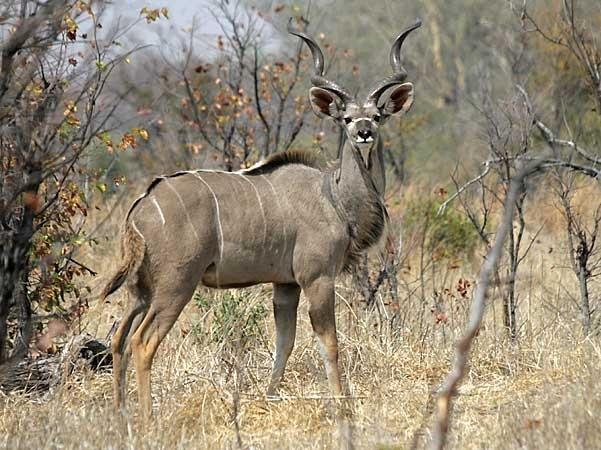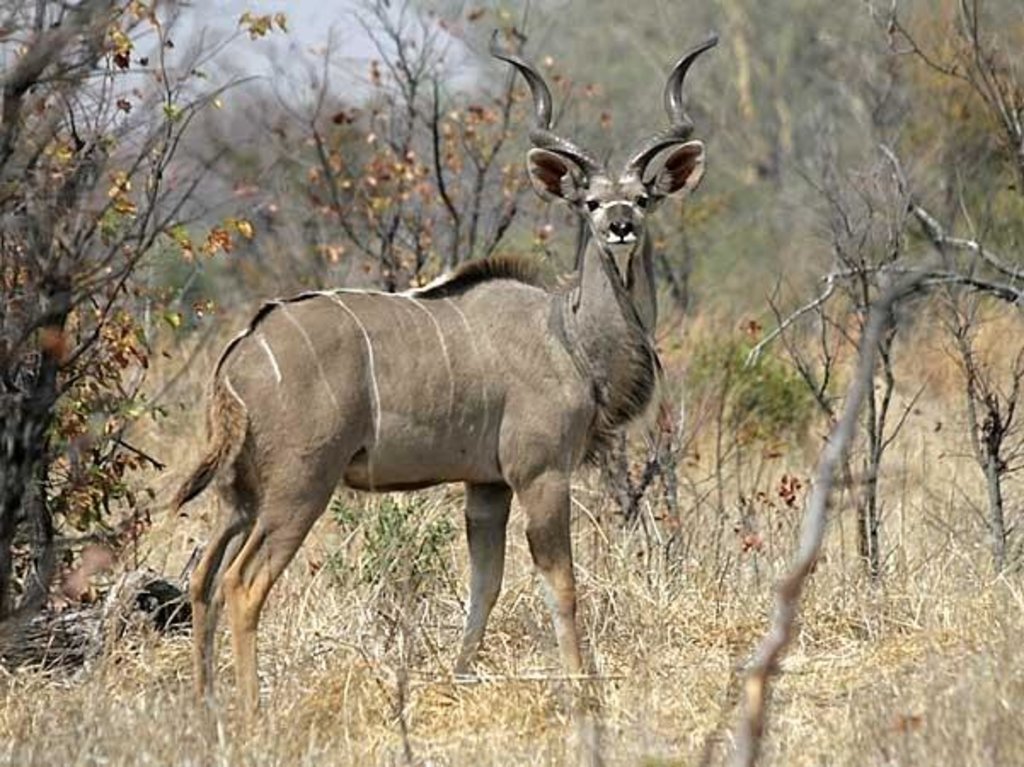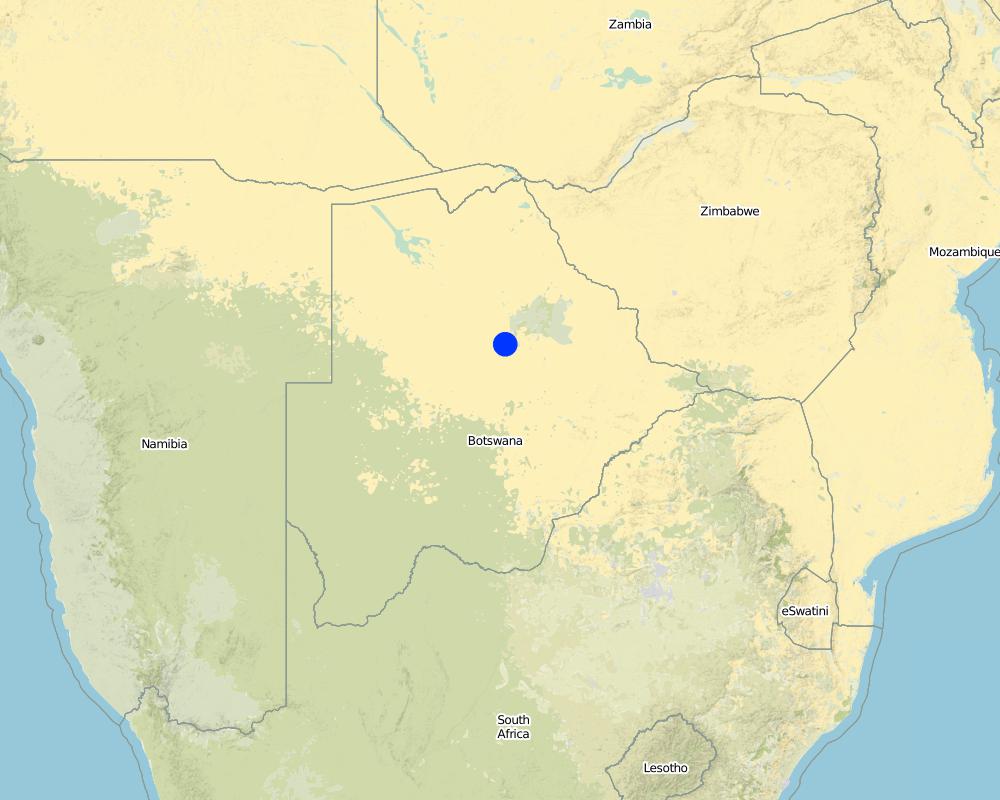Game Ranching [博茨瓦纳]
- 创建:
- 更新:
- 编制者: Wanda Mphinyane
- 编辑者: –
- 审查者: Fabian Ottiger, Alexandra Gavilano
Thuo ya diphologolo (Wildlife Ranching)
technologies_1386 - 博茨瓦纳
查看章节
全部展开 全部收起1. 一般信息
1.2 参与该技术评估和文件编制的资源人员和机构的联系方式
SLM专业人员:
Perkins Jeremy
University of Botswana
博茨瓦纳
有助于对技术进行记录/评估的机构名称(如相关)
University of Botswana (University of Botswana) - 博茨瓦纳1.3 关于使用通过WOCAT记录的数据的条件
编制者和关键资源人员接受有关使用通过WOCAT记录数据的条件。:
是
2. SLM技术的说明
2.1 技术简介
技术定义:
To conserve/sustain rangeland through controlled grazing of wildlife enterprise
2.2 技术的详细说明
说明:
This is a community project that proposesto farm wildlife in a ranch. The community will seek the land through the Land-board authorities. Department of wildlife (which is incharge of wildlife) will be consulted on animal species to ranch or to bring in. The main inputs will include fencing the ranch, water provision and labour to run the enterprise (a to be incurred by the community). The proposal has to be approved by the Department of Wildlife and National Parks who are incharge of all wildlife in the country. This will be done after the Rang Ecologists have surveyed the vegetation of the area; its suitability for game ranching. The purpose of this technology is to utilize some of the the available resources in the area so as to reduce poverty among the community members through returns gained from the enterprise and to conserve rangeland because wildlife species are more efficient users of semi - arid ecosystems. The community will seek land for game ranching from the land-board. Fencing is a pre-requisit in game faming for the purpose of rangeland conservation through controlled grazing. Water provision is also anecessity of which whould be well distributed within the ranch. Local wildlife species will be used to stock the ranch and if necessary some may be brought in from elsewhere. All the expenses will be the responsibility of the community. Day to day work in the ranch will be done by the community while technical advise will be provided by relevant expertise. Thetechnical knowledge from the community is very limited or low, professional advice would be needed time and again. The SLM technology is located on the fringes of the Makgadikgadi Salt Panswhich are prone to salty water, dusty locations because of bare ground and very fine soils. The community is of rural type where livilihoods are subsistence farming. The community is oriented more to livestock farming than to crop farming. Rangeland degradation is evident in the regionbecause of overstocking. Rainfall in the area is unpredictable and erratic with a mean of 450 - 500 mm per annum
2.3 技术照片
2.5 已应用该技术的、本评估所涵盖的国家/地区/地点
国家:
博茨瓦纳
区域/州/省:
Boteti
有关地点的进一步说明:
Central District
具体说明该技术的分布:
- 均匀地分布在一个区域
如果技术均匀分布在一个区域,则指定覆盖的区域(单位为平方千米):
10.0
如果不知道精确的区域,请注明大致覆盖的区域:
- 10-100 平方千米
注释:
Total area covered by the SLM Technology is 10k m2.
SLM technology area (Ranch) still to be idntified through consultation with Land-board authorities
Map
×2.6 实施日期
如果不知道确切的年份,请说明大概的日期:
- 50多年前(传统)
2.7 技术介绍
详细说明该技术是如何引入的:
- 作为传统系统的一部分(> 50 年)
注释(项目类型等):
This area is traditionally a wildlife area, and these people have been living with wild animals and hunting to supplement their food for many years
3. SLM技术的分类
3.1 该技术的主要目的
- 减少、预防、恢复土地退化
3.2 应用该技术的当前土地利用类型
同一土地单元内混合使用的土地::
是
具体说明混合土地使用(作物/放牧/树木):
- 农牧业(包括农牧结合)

农田
- 一年一作
年作 - 具体指明作物:
- 谷物类 - 玉米
- 谷类 - 高粱
- 豆科牧草和豆类 - 豆子
- 蔬菜 - 香瓜、南瓜、南瓜或葫芦
每年的生长季节数:
- 1
具体说明:
Longest growing period in days: 140 Longest growing period from month to month: Oct - Mar

牧场
粗放式放牧:
- 半游牧畜牧业
- 经营牧场
注释:
Major cash crops: Sorghum, beans, melons, sweet- reeds
Major food crop: Sorghum, maize, beans, Bambara beans
Major land use problems (compiler’s opinion): Communal land use with limited management. Saline water, droughts, overgrazing by livestock
Major land use problems (land users’ perception): Low formal education among members of the community
Semi-nomadism / pastoralism: With permanent place of residence
Ranching: Fenced grazing area with water borehole
Grazingland comments: Residents have cattle posts, crop-land and residential homes and move to these places each time. Game ranching is not applied in the Boteti area at the moment
Type of cropping system and major crops comments: Mixed cropping is traditional practice but government extension advise promote monocropping of which the majority find expensive and risky
Livestock is grazing on crop residues
Livestock density: 1-10 LU /km2
3.4 供水
该技术所应用土地的供水:
- 雨养
3.5 该技术所属的SLM组
- 区域封闭(停止使用,支持恢复)
3.6 包含该技术的可持续土地管理措施

植物措施
- V1:乔木和灌木覆盖层
- V2:草和多年生草本植物
- V3:植被的清理

管理措施
- M1:改变土地使用类型
- M2:改变管理/强度级别
注释:
Main measures: vegetative measures
Secondary measures: management measures
3.7 该技术强调的主要土地退化类型

土壤水蚀
- Wt:表土流失/地表侵蚀

土壤风蚀
- Et:表土流失
注释:
Main type of degradation addressed: Et: loss of topsoil
Secondary types of degradation addressed: Wt: loss of topsoil / surface erosion
Main causes of degradation: overgrazing, land tenure (Communal grazing land)
Secondary causes of degradation: deforestation / removal of natural vegetation (incl. forest fires), over-exploitation of vegetation for domestic use, poverty / wealth (limited employment and income generating employment activities), population density (more animinals - overgrazing)
3.8 防止、减少或恢复土地退化
具体数量名该技术与土地退化有关的目标:
- 防止土地退化
- 减少土地退化
注释:
Main goals: prevention of land degradation
Secondary goals: mitigation / reduction of land degradation
4. 技术规范、实施活动、投入和成本
4.1 该技术的技术图纸
技术规范(与技术图纸相关):
Technical knowledge required for field staff / advisors: high (Very important)
Technical knowledge required for land users: moderate (Should have knowledge)
Main technical functions: increase of biomass (quantity), promotion of vegetation species and varieties (quality, eg palatable fodder)
Secondary technical functions: increase in organic matter, increase in nutrient availability (supply, recycling,…), increase of infiltration
Change of land use type: Game Ranching
4.2 有关投入和成本计算的一般信息
其它/国家货币(具体说明):
Pula
如相关,注明美元与当地货币的汇率(例如1美元=79.9巴西雷亚尔):1美元=:
7.0
注明雇用劳工的每日平均工资成本:
8.00
4.3 技术建立活动
| 活动 | 时间(季度) | |
|---|---|---|
| 1. | Fencing Material | 1 |
| 2. | Construction of Fences | 1 |
| 3. | Borehole drilling (water source) | 1 |
| 4. | Handling facilities | 1 |
4.4 技术建立所需要的费用和投入
| 对投入进行具体说明 | 单位 | 数量 | 单位成本 | 每项投入的总成本 | 土地使用者承担的成本% | |
|---|---|---|---|---|---|---|
| 劳动力 | Labour | 1.0 | 4.29 | 4.29 | ||
| 施工材料 | Fencing material | 1.0 | 3883.0 | 3883.0 | ||
| 其它 | Borehole | 1.0 | 12.36 | 12.36 | ||
| 技术建立所需总成本 | 3899.65 | |||||
| 技术建立总成本,美元 | 557.09 | |||||
注释:
Duration of establishment phase: 9 month(s)
4.5 维护/经常性活动
| 活动 | 时间/频率 | |
|---|---|---|
| 1. | Labour looking after the ranch | Permanently based at ranch |
| 2. | Engine fuel | 2,000 litres per year |
| 3. | Borehole maintenance | once per year |
| 4. | Fence Maintenance | once in 10 years |
4.6 维护/经常性活动所需要的费用和投入(每年)
| 对投入进行具体说明 | 单位 | 数量 | 单位成本 | 每项投入的总成本 | 土地使用者承担的成本% | |
|---|---|---|---|---|---|---|
| 劳动力 | Labour | 1.0 | 2.51 | 2.51 | ||
| 施工材料 | Fencing material | 1.0 | 158.0 | 158.0 | ||
| 其它 | Borehole | 1.0 | 0.54 | 0.54 | ||
| 技术维护所需总成本 | 161.05 | |||||
| 技术维护总成本,美元 | 23.01 | |||||
注释:
Calculations are based on a Game Ranch of 6 km x 6 km or 3600 hactres
4.7 影响成本的最重要因素
描述影响成本的最决定性因素:
Labour and Fencing material affected the cost of the ranch
5. 自然和人文环境
5.1 气候
年降雨量
- < 250毫米
- 251-500毫米
- 501-750毫米
- 751-1,000毫米
- 1,001-1,500毫米
- 1,501-2,000毫米
- 2,001-3,000毫米
- 3,001-4,000毫米
- > 4,000毫米
指定年平均降雨量(若已知),单位为mm:
450.00
有关降雨的规范/注释:
Seasonal summer rains
农业气候带
- 半干旱
Thermal climate class: subtropics. Wet and dry season - subtropical. Open tree savannah (length of growing period = 75 - 179 days)
5.2 地形
平均坡度:
- 水平(0-2%)
- 缓降(3-5%)
- 平缓(6-10%)
- 滚坡(11-15%)
- 崎岖(16-30%)
- 陡峭(31-60%)
- 非常陡峭(>60%)
地形:
- 高原/平原
- 山脊
- 山坡
- 山地斜坡
- 麓坡
- 谷底
垂直分布带:
- 0-100 m a.s.l.
- 101-500 m a.s.l.
- 501-1,000 m a.s.l.
- 1,001-1,500 m a.s.l.
- 1,501-2,000 m a.s.l.
- 2,001-2,500 m a.s.l.
- 2,501-3,000 m a.s.l.
- 3,001-4,000 m a.s.l.
- > 4,000 m a.s.l.
关于地形的注释和进一步规范:
Altitudinal zone: 501-1000 m a.s.l. (Part of Makgadikgadi Basin)
Landforms: Plateau/plains (Flat plains with pans)
Slopes on average: Flat (ranked 1, low to flat land dominated by pans) and gentle (ranked 2, gentle topography (plains))
5.3 土壤
平均土层深度:
- 非常浅(0-20厘米)
- 浅(21-50厘米)
- 中等深度(51-80厘米)
- 深(81-120厘米)
- 非常深(> 120厘米)
土壤质地(表土):
- 粗粒/轻(砂质)
- 细粒/重质(粘土)
表土有机质:
- 中(1-3%)
- 低(<1%)
如有可能,附上完整的土壤描述或具体说明可用的信息,例如土壤类型、土壤酸碱度、阳离子交换能力、氮、盐度等。:
Soil depth on average: Deep (ranked 1, sandy areas away from pans) and very shallow (ranked 2, cacareous - generally soils - about 40cm deep)
Soil texture: Coarse/light (ranked 1, away from depressions or pans - bacground soils) and fine/heavy (ranked 2, found in depressions)
Soil fertility: Very low (ranked 1, sandy soils - Arenosols) and medium (ranked 2, molapo farming - farming on flood plains)
Topsoil organic matter: Low (ranked 1, sandy areas are low in OM) and medium (ranked 2, flood plains - farming area)
Soil drainage/infiltration: Good (ranked 1, sandy soils are good in drainage) and medium (ranked 2, flood areas are medium)
Soil water storage capacity: Very low (ranked 1, sandy areas are low) and medium (ranked 2, flood areas)
5.4 水资源可用性和质量
地下水位表:
> 50米
地表水的可用性:
匮乏/没有
水质(未处理):
不良饮用水(需要处理)
关于水质和水量的注释和进一步规范:
Ground water table: > 50 m (ranked 1, boreholes) and 5-50 m (ranked 2, and dug Wells)
Availability of surface water: Poor/none (unreliable river flow. Available from pans during rainy sesons)
Water quality (untreated): Poor drinking water (treatment required, salty water in most areas)
5.5 生物多样性
物种多样性:
- 低
关于生物多样性的注释和进一步规范:
Biodiversity:
Low (ranked 1, low in communal grazing rangeland)
High (ranked 2, protected areas - game reserves)
5.6 应用该技术的土地使用者的特征
非农收入:
- 低于全部收入的10%
相对财富水平:
- 非常贫瘠
- 非常丰富
个人或集体:
- 团体/社区
机械化水平:
- 畜力牵引
- 机械化/电动
性别:
- 女人
- 男人
说明土地使用者的其他有关特征:
Land users applying the Technology are mainly common / average land users
Population density: < 10 persons/km2
Annual population growth: 2% - 3%
30% of the land users are very rich and own 20% of the land (Cattle ranchers).
60% of the land users are average wealthy and own 30% of the land (Average farmes).
10% of the land users are poor and own 50% of the land (Subsistance farmers).
Off-farm income specification: Income opportunities for everyone in the area
Level of mechanization: Animal traction (ranked 1, draft animals such as oxen and donkeys) and mechanised (ranked 2, tractors)
Market orientation of production system: subsistence (self-supply), mixed (subsistence/ commercial), commercial/ market (tourism)
5.7 应用该技术的土地使用者使用的平均土地面积
- < 0.5 公顷
- 0.5-1 公顷
- 1-2 公顷
- 2-5公顷
- 5-15公顷
- 15-50公顷
- 50-100公顷
- 100-500公顷
- 500-1,000公顷
- 1,000-10,000公顷
- > 10,000公顷
这被认为是小规模、中规模还是大规模的(参照当地实际情况)?:
- 小规模的
注释:
Average area of land owned or leased by land users applying the Technology on grazing land:
5-15 ha (ranked 1, land is tribal owned - no individual household grazing of land - communal grazing)
1,000-10,000 ha (ranked 2, for fenced farms - rich farmers)
Size of grazing land per household. The land tenure system is that ofcommunity grazing- tribal land. Individual grazing land is very limited (private leasehold ranches). Most of the land is communal owned and the community graze their animals extensily, which means, there is no cotrol of grazing, no individual ownership of land but the tribe. Individuals can keep as many animals as they wish. However, each individual looks after his /her own animals for management purposes (water provision, castration, deworming, guard agaist predators etc)
Average area of land owned or leased by land users applying the Technology oncropland: 5-15 ha: On average is small fields
5.8 土地所有权、土地使用权和水使用权
土地所有权:
- 社区/村庄
- 个人,未命名
土地使用权:
- 自由进入(无组织)
- 个人
用水权:
- 自由进入(无组织)
- 个人
注释:
Land is open access for use. Some individual own water wells. Dual grazing rights for private ranchers
5.9 进入服务和基础设施的通道
健康:
- 贫瘠
- 适度的
- 好
教育:
- 贫瘠
- 适度的
- 好
技术援助:
- 贫瘠
- 适度的
- 好
就业(例如非农):
- 贫瘠
- 适度的
- 好
市场:
- 贫瘠
- 适度的
- 好
道路和交通:
- 贫瘠
- 适度的
- 好
饮用水和卫生设施:
- 贫瘠
- 适度的
- 好
金融服务:
- 贫瘠
- 适度的
- 好
6. 影响和结论性说明
6.1 该技术的现场影响
社会经济效应
生产
作物生产
作物质量
饲料生产
饲料质量
畜牧生产
木材生产
森林/林地质量
非木材林业生产
生产故障风险
产品多样性
生产区域
土地管理
能源生产
水资源可用性和质量
饮用水的可用性
饮用水的质量
家畜用水的可用性
家畜用水的质量
灌溉用水的可用性
灌溉用水的质量
灌溉用水需求
收入和成本
农业投入费用
农业收入
收入来源的多样性
经济差异
工作量
社会文化影响
食品安全/自给自足
健康状况
土地使用权/用水权
文化机会
娱乐机会
社区机构
国家机构
SLM/土地退化知识
冲突缓解
注释/具体说明:
Increased economic inequity
社会经济弱势群体的情况
Improved livelihoods and human well-being
注释/具体说明:
Technology not yet applied in Boteti
生态影响
水循环/径流
水量
水质
水的回收/收集
地表径流
多余水的排放
地下水位/含水层
蒸发
土壤
土壤水分
土壤流失
土壤堆积
土壤结壳/密封
土壤压实
养分循环/补给
盐度
土壤有机物/地下C
酸度
生物多样性:植被、动物
植被覆盖
生物量/地上C
植物多样性
外来入侵物种
动物多样性
有益物种
栖息地多样性
害虫/疾病控制
减少气候和灾害风险
碳和温室气体的排放
6.2 该技术的场外影响已经显现
水资源可用性
旱季稳定可靠的水流
下游洪水
下游淤积
地下水/河流污染
缓冲/过滤能力
风力搬运沉积物
6.3 技术对渐变气候以及与气候相关的极端情况/灾害的暴露和敏感性(土地使用者认为的极端情况/灾害)
渐变气候
渐变气候
| 季节 | 增加或减少 | 该技术是如何应对的? | |
|---|---|---|---|
| 年温度 | 增加 | 好 |
气候有关的极端情况(灾害)
气象灾害
| 该技术是如何应对的? | |
|---|---|
| 局地暴雨 | 好 |
| 局地风暴 | 好 |
气候灾害
| 该技术是如何应对的? | |
|---|---|
| 干旱 | 不好 |
水文灾害
| 该技术是如何应对的? | |
|---|---|
| 比较和缓的(河道)洪水 | 好 |
其他气候相关的后果
其他气候相关的后果
| 该技术是如何应对的? | |
|---|---|
| 缩短生长期 | 好 |
注释:
Drought/long dry spells are very risky to the survival of game animals because of decreased forage production and drinking water. Therefore, flexiblestockng rates and water sources are needed
6.4 成本效益分析
注释:
Project not yet started, but once established the project can run and maintain itself
6.5 技术采用
注释:
Comments on acceptance with external material support: All interested persons are whle heartedly wishing to have a ranchto farm wildlife. Problem is that the venture costs a lot of funds
Comments on spontaneous adoption: Project not yet started
There is a strong trend towards spontaneous adoption of the Technology
Comments on adoption trend: This is the technology that rated at the top of the list. The community is really interested and want to do the project, but unfortunately funds do not permit
6.7 该技术的优点/长处/机会
| 土地使用者眼中的长处/优势/机会 |
|---|
|
Need more land How can they be sustained / enhanced? Need a sponsor to establish the ranch |
| Need hands from the government |
|
To stock more diverse animal species How can they be sustained / enhanced? Supplement animals with hay and fodder |
| 编制者或其他关键资源人员认为的长处/优势/机会 |
|---|
|
Technology can enhence the livilihoods of the community How can they be sustained / enhanced? Addition of extra animal species to attract the tourists |
|
Less management compared to livestock production How can they be sustained / enhanced? Good management |
| Wildlife is more adapted to the grazing conditions |
|
Returns from the enterprise is faster How can they be sustained / enhanced? Good management and commitment |
6.8 技术的弱点/缺点/风险及其克服方法
| 土地使用者认为的弱点/缺点/风险 | 如何克服它们? |
|---|---|
| Secure land from land-board authorities | Community project given preference |
| Wildlife and livestock competition/conflict for grazing areas | Some mediation needed from authority - compromise |
| Predators |
| 编制者或其他关键资源人员认为的弱点/缺点/风险 | 如何克服它们? |
|---|---|
| Very expensive to extablish a game ranch | Source for a sponsor |
| Productivity of the area is low (13 - 16 ha per livestock unit) | More land needed to stock more animals |
| Poor plant diversity | Land rehabilitation through use of correct stocking rate |
| Predator problem | |
| Conflict between wildlife and livestock production |
7. 参考和链接
7.1 信息的方法/来源
7.2 参考可用出版物
标题、作者、年份、ISBN:
Wire Fences: VanRooyen, JB Du Toit & Van Rooyen. 2001
可以从哪里获得?成本如何?
Book available in Web
标题、作者、年份、ISBN:
Overview of Game Ranching in Southern Africa: D. Grossman and PL Holden
可以从哪里获得?成本如何?
Report
标题、作者、年份、ISBN:
Upfront cost of Game ranching
可以从哪里获得?成本如何?
Book available in Web
链接和模块
全部展开 全部收起链接
无链接
模块
无模块




